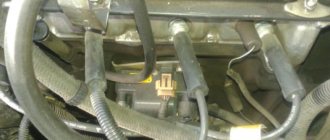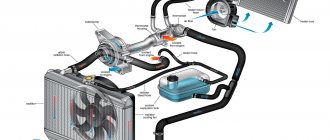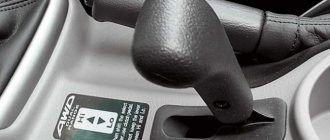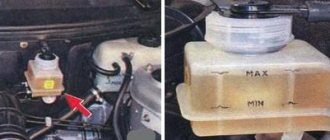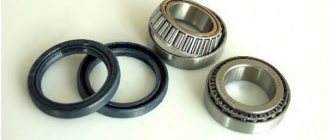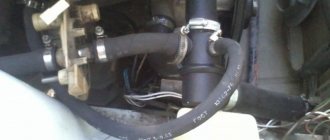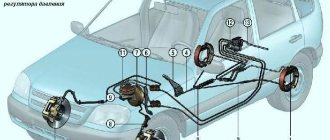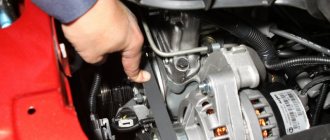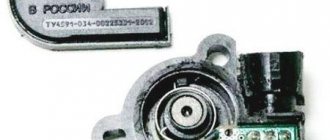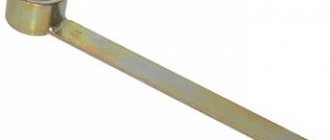Low prices for motor oil
Chevrolet Niva is the most affordable all-wheel drive SUV on the Russian market. Despite the outdated design, the car is still as relevant as ever. This is facilitated not only by the utilitarian classic design, but by the legendary maintainability. The simple design allows you to service the car in a garage using available tools. It will not be difficult to change the oil in the gearbox, but special attention in this article is paid to the volume of oil in the transmission. However, it is equally important to know other parameters, including the frequency of oil changes, how to choose the right one, and which best brands to choose.
Regulations
In the case of the Chevrolet Niva, the plant recommends replacing the transmission substance every 45 thousand kilometers. It is noteworthy that in this case the manufacturer took into account difficult operating conditions. However, this car is precisely intended for heavy road testing. The SUV tolerates overloads well, and the powerful and durable suspension provides excellent ride comfort and outstanding cross-country ability. We are talking about something else - the service life of the oil, which in such operating conditions will have to be changed much more often than required according to the regulations. Therefore, the 45 thousand kilometers limit can be called conditional. In addition, the endurance of the oil is also negatively affected by the human factor, namely the driver’s mistakes, which he makes in harsh conditions - for example, he incorrectly shifts from one gear to another (or does not operate the clutch correctly), constantly exceeds the speed, makes sudden maneuvers, etc. etc. At the same time, you can add here dirt and slush on the roads, high humidity, and various precipitation (for example, rain with snow and hail). Based on this, we can conclude: even if the car is adapted to heavy loads, this does not mean that the oil in such conditions is also designed for a long service life. Over time, it will lose its properties, but in this situation it will happen much earlier. Therefore, more frequent oil changes cannot be avoided. For example, experienced Niva owners prefer to reduce the regulations to 30 or 25 thousand. In addition, they check the oil volume in advance and constantly monitor its condition.
Power unit
The engine installed on the modern model of the Niva 21213 (214) car was inherited from its Soviet progenitor - the VAZ 2121, and in terms of fluid volumes they are almost identical:
- Liquid cooling system. Filled with antifreeze in an amount of 10.7 liters with a freezing point not higher than -40 ° C. The capacity of the interior heating radiator is also included in this volume.
- Crankcase. Motor oils are poured here, the brand of which depends on the operating conditions. Capacity: 3.75 liters, including oil filter filling.
| Lower limit of ambient temperature, °C | -20 | -25 | -25 | -30 | -30 | -15 | -35 | -30 |
| Upper limit of ambient temperature, °C | 45 | 35 | 45 | 35 | 45 | 45 | 25 | 30 |
| SAE lubricant viscosity grade | 15W-40 | 10W-30 | 10W-40 | 5W-30 | 5W-40 | 20W-40 | 0W-30 | 0W-40 |
When flushing the power unit during the process of replacing liquid lubricant, the same amount of flushing oil (3.75 l) is used, taking into account the size of the filter. Replacement is carried out after 8-12 thousand kilometers, depending on the quality of the oil. Flushing is usually performed after 3 engine lubricant changes. During operation, it is important to monitor the oil level in the engine crankcase using a special dipstick. If the level drops below the Min mark, it is urgent to add lubricant to the engine of the same viscosity as was previously filled.
Antifreeze needs to be updated at least once every 3 years or according to the degree of wear of the fluid. It is not recommended to dilute antifreeze with distilled water, either in winter or summer. In winter, the diluted liquid may freeze, and during the summer heat it may boil ahead of time, which will lead to overheating of the engine.
Checking the volume and condition of the oil
The level of remaining oil in the transmission is checked with a special dipstick, which shows two dimensional marks - Max and Min. Using them you can determine whether there is enough oil in the box. If the fluid is below the minimum standard (Min), then you will still have to add a little oil. At the same time, it is important to prevent overflow, otherwise another problem will arise - you will have to crawl under the hood and drain the excess oil. The oil is brought to the optimal level - between the Max and Min marks. This procedure can be completed in a few minutes, but unfortunately, it is only relevant for short runs.
High car mileage or untimely oil changes are just two of the many reasons why you should check the condition of the oil. In such cases, the likelihood that the fluid is no longer able to effectively cool the transmission parts and prevent them from overheating increases significantly. This is indicated by the following factors - cloudy and darkened color of the oil, as well as an unpleasant specific odor, or even worse - the presence of metal particles inside the oil. Once you are convinced that the oil is unsuitable, you need to start replacing it as quickly as possible.
When and how to pour oil into a Chevrolet Niva box
Many inexperienced owners of new cars do not even suspect that changing the gearbox oil is as necessary as changing the engine lubricant. For example, updating the oil fluid inside a Chevrolet Niva manual transmission is done after 45–50 thousand kilometers. This requires special gear oils. In addition to the manual gearbox, the transmission also includes a transfer case. There you also need to change the oil, at the same mileage interval as the gearbox.
Functioning of the checkpoint
The Niva Chevrolet gearshift mechanism is five-speed mechanical. Its main function is to change the torque transmitted from the engine to the wheels. The manual transmission has a three-shaft design. Unfortunately, the Niva Chevrolet gearbox, having a complex design, often fails. It should be noted that its repair is quite expensive. Therefore, it is important to periodically check the lubricant level and change the oil in the gearbox on time.
For this purpose, transmission fluid of API GL-4 standard with viscosity of 75W-90 and 80W-90 is used. They are produced by both domestic manufacturers (TNK and Lukoil) and foreign ones - Shell, Mobil, Castrol, Total, ZIC, Motul. Of all the above, the French lubricant Motul Gear 300 75W-90 showed the best performance in terms of protection against scuffing, film stability on contacting surfaces, and anti-wear characteristics.
In second place was Castrol Syntrans Transaxle 75W-90 transmission fluid, third was Mobil Mobilube 75W-90 oil. All of them can operate at temperatures from -35 to +35°C, ensuring easy gear shifting and stable operation of the manual transmission. The price of these products is quite high, so it is worth paying attention to the domestic semi-synthetic transmission made by Lukoil - TM-4 75W-90. It is not much inferior to foreign competitors, but at the same time it is much cheaper and better adapted to low temperatures. The manufacturer also allows the use of transmission fluids of viscosity 80W-90 and 80W-85.
It should be remembered that you cannot fill the gearbox with API GL-5 standard transmission oil. In terms of its performance, it seems to be better - it can operate at high speeds and loads, as well as high temperatures. But it contains sulfur-phosphorus extreme pressure additives, a large amount of which can simply “kill” the gearbox synchronizers. They contain bronze, not durable steel. A large number of such additives are contraindicated for her. Therefore, compositions of the GL-5 standard should be poured into axles and gearboxes.
Transfer case
This is another important transmission unit of the Chevrolet Niva. It includes a range multiplier and a lockable center differential. The transfer case also changes the amount of torque, but not in the same way as the gearbox. In addition, it distributes it between the axles, front and rear, maintaining a 50:50 ratio. The differential is locked to improve maneuverability if road conditions are very difficult.
The transfer case (in the picture its lever is 2) can be switched similarly to a gearbox, only the purpose of the lever shifts is completely different. There is a neutral position (NII–V). There is a high gear (HI) used for normal road conditions, with the differential unlocked. If it needs to be blocked, transmission (HIV) is activated. In difficult areas, the lever switches to LIII if the differential does not yet need to be locked. If it’s really difficult to drive, you need to switch to LIV, blocking the bridges between them. The wheels then rotate at the same speed.
You can switch from the Low position (L - low gear) to the High position (H - high gear) while driving. In this case, you should squeeze the clutch twice, because the transfer case does not have synchronizers. Switching from H to L positions is only possible after the vehicle has stopped. In addition, you cannot lock the differential at high speeds, as you can lose control of the car when cornering. The transfer case uses the same gear oil that is used for the gearbox.
Changing the lubricant in the manual transmission
The first oil change in the gearbox after purchasing a car is done after 60,000 km. The next time you will need to change the oil is after 45,000 km. In the future, this interval will have to be observed constantly.
How much oil do you need to fill? To optimally fill the oil into the box, you will need a transmission fluid volume of 1.6 liters. It is most convenient to immediately change the lubricant in the transfer case, since they have the same service life.
Do not forget that every 15,000 km it is necessary to check the level of transmission fluid - both in the gearbox and in the transfer case.
It happens that extraneous sounds (grinding) are heard from the gearbox - when changing gears and while driving. This indicates an oil leak. The culprit may be a leaky secondary shaft oil seal, through which lubricant is leaking. Before changing the lubricant, you need to prepare tools and available materials: If you also make a change in the transfer case, you should immediately purchase 2.5 liters of oil - 1.6 liters for the gearbox and 0.8 liters for the transfer case. Changing the oil in the gearbox involves a certain sequence of actions:
- You must first drive at least 5 km to warm up the oil in the transmission.
- The car is placed on a lift or above an inspection hole.
- The body and plugs are cleaned - drain and filler.
- The filler plug is unscrewed.
- Place a container under the drain, after which it is also unscrewed, the lubricant completely flows out.
- The drain plug magnet is cleaned of adhering chips - signs of wear on gearbox parts.
- The drain plug is screwed in, the gearbox is filled with flushing fluid with a volume of about 1 liter.
- The transfer case is switched to neutral, the engine starts, and the gearbox shifts within 3 minutes.
- The engine turns off and the flushing is completely drained.
- New lubricant is poured through the filler hole, the amount is about 1.6 liters.
- As oil arrives, its level is periodically checked.
- The engine starts, first gear is engaged and it all works for 5 minutes.
- Then the oil composition is added to the desired level.
This completes the oil change in the Chevrolet Niva gearbox.
Changing the oil in the transfer case
We change the oil inside the transfer case in a similar way. For work, you should prepare the same materials and lubricant, but washing is not necessary.
You also need to warm up the car’s transmission and drive either onto an overpass or into a viewing hole.
- The filler plug is unscrewed.
- A container is placed to receive the waste liquid.
- The drain plug is unscrewed and the liquid is drained to the last drop.
- The magnet of the plug is cleaned of metal shavings.
- Approximately 1 liter of lubricant is poured with a syringe until its level reaches the filler hole.
- The filler plug is tightened, the operation of the ventilation valve is checked, and it is cleaned if necessary.
At this point, all operations for changing the oil inside the gearbox, as well as the transfer case, are completed. You can drive another 45,000 km until the next replacement.
Related publications
motoroilclub.ru
Choosing oil for manual transmission Chevrolet Niva
To be sure of the quality and reliability of the oil, it should be selected according to the parameters developed by the engineers of the GM-AvtoVAZ concern. For example, first of all, one must proceed from the viscosity characteristics, namely, pay attention to the 80W-90 marking with the specification GL-4 or GL-5.
Type of oil - synthetic, mineral and semi-synthetic. The synthetic product is considered the best among all presented. This is the most fluid and liquid oil with a long service life.
Semi-synthetics and mineral water can also be used for Chevrolet Niva, but only with high mileage and in warm weather.
Having understood the parameters, we will decide on the choice of a suitable brand. Among the most recognized are the products of Castrol, Shell, Lukoil, Rosneft, G-Energy, Mobil and others.
Brake fluid Niva Chevrolet, gourmet
brake fluid DOT-4+, Brembo
In 2020, I began to work very closely with the trendsetter in brakes, the Italian concern Brembo. I was sent a dealer catalog and in the service section I found brake fluid. The jar contains the company logo, the inscription “made in Italy”, and product characteristics. A technician confirmed that this product is made in-house. The price is a little more expensive than competitors, but it's worth it. Kinematic viscosity (pumpability) at minus 40 is 1400 cCt (DOT-4 – 1800), which allows it to be classified as DOT-4+ and used in cold climates.
Did you like the article? Share with your friends!
63
How much to fill
The volume of fluid poured into the Chevrolet Niva gearbox is 1.6 liters. This is how much oil will fit after completely cleaning the gearbox from old substances and various deposits. A complete transmission flush is necessary for high mileage. The procedure is performed at a dealership or at home. The most important thing here is the flushing stage, during which a special substance is circulated throughout the entire transmission with the engine running. Then the flushing liquid is drained from the box, and then new oil is introduced in the specified volume of 1.6 liters. The liquid level is adjusted to normal using a dipstick.
View oil prices
Brake fluid Niva Chevrolet, choice
brake fluids
Let's take the following fact as an axiom - almost NONE of the leading manufacturers of pads or brake components makes their own brake fluid. It is made either by chemical concerns or manufacturers of auto chemicals and oils. Example. Everything that is in jars of the TRW, BMW, ATE brands is made by manufacturers ROWE, BASF, Pentosin, ELF-TOTAL. Therefore, when I selected suppliers, I was guided by the following thought. A well-known company that deals with brake systems simply will not disgrace itself and sell a low-quality product in its own name. That's why I settled on Bosch, TRW, Brembo products. To fully pump the system of our car, 1 liter of product is enough. There is still some left for refilling.
Characteristics
The Neva universal brake fluid was developed at one time for use in domestic passenger cars such as Moskvich and Zhiguli, and therefore is fully compatible with brake fluids such as Tom and Rosa. Its physical and mechanical properties are as follows:
- The temperature range for practical use is ±500C.
- The starting boiling point is 1950C.
- Kinematic viscosity, cSt, at temperatures up to 500C – no more than 6.2.
- Kinematic viscosity, cSt, at temperatures up to -400C – no more than 1430.
- Corrosive activity to other metals is insignificant.
- The starting temperature for thickening is -500C.
- The change in boiling point after long-term storage is ±30C.
- Flash point – 940C.
- Volumetric swelling of rubber parts at temperatures up to 1200C is no more than 3%.
Minor corrosion activity is possible only with prolonged contact of this brake fluid with aluminum parts.
